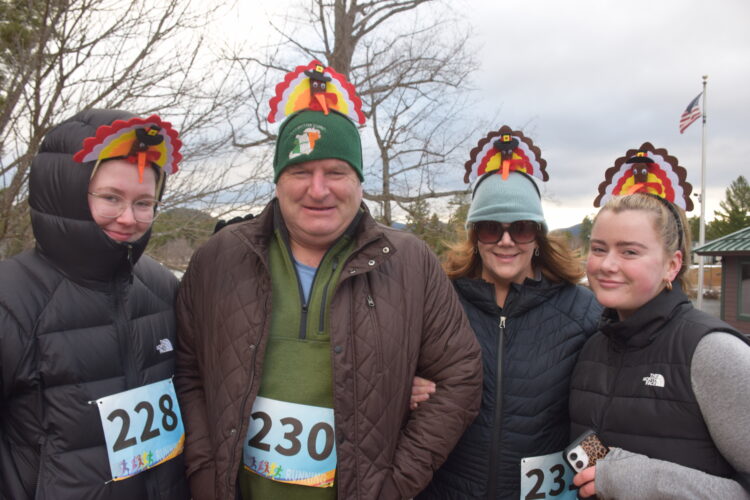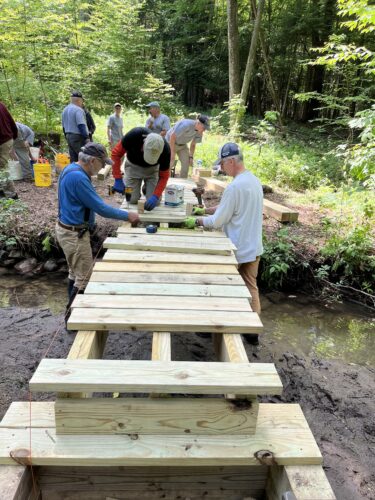Restoring Keene’s cemeteries

Margaret Hawthorn, assistant archivist at the Keene Valley Library, details the various sources of Adirondack lore and information in the archives. (Provided photo)
KEENE — There are 11 cemeteries within the town of Keene. All but two, Norton and Norton Brook, have long been retired, and eight are in various stages of neglect and disrepair.
Why not restore them?
Originally, the idea to restore the Estes Cemetery came from Blaikie Worth, of New York City and Keene Valley. Living near the old graveyard, she had watched its gradual deterioration year after year. Margaret Hawthorn, Keene Valley Library’s assistant archivist, and Peter Slocum, Essex County Historical Association trustee, responded, and the project took off from there.
On July 29, at Keene Valley Library, Slocum, with Hawthorn, presented a talk: “Restoring Keene Cemeteries and Unearthing Keene Stories” to an audience of 55 people. Slocum quoted storyteller Willem Lange, who wrote, “All the old cemeteries are repositories of hundreds of fascinating stories — most of them, sadly, forgotten.” Both Slocum and Hawthorn spoke about the beginning of the Estes Cemetery restoration.
In the autumn of 2023, a team of volunteers joined Hawthorn and Slocum to work on the Estes Cemetery, which is located off Beede Lane in Keene Valley. Donna Reed Austin, Tom and Alana Both and Ann Sayers helped clear away fallen tree limbs and debris, rake leaves and straighten the perimeter fence. Later they would replace the fence.
Using a soft brush with water and a cleaning spray called D-2, they were able to restore gravestones, if not to their original condition, at least to legibility. (D-2, designed specifically for gravestones, is used at Arlington National Cemetery.) The Worth family granted funding for the restoration project. By law, the town is responsible for the upkeep of the retired cemeteries, but only to maintain a fence and mow once a year.
Keene Town Supervisor Joe Pete Wilson contributed to the project by supplying gravel to use in resetting and supporting gravestones, many of which were leaning or fallen; some had sunk into the ground and disappeared. The town also paid for new split rail fencing to replace the dilapidated metal fence.
The team needed a tripod in order to raise and reset heavy stones, but were deterred by the cost of purchasing one. Timber frame contractor Stephen Amstutz of Jay came to the rescue by supplying the materials to build a tripod, and ended up putting it together as well, Hawthorn remembers. The earliest known grave is from 1803. Yet to be investigated: According to local tradition, there may be 16 unmarked graves in the northeast corner of Estes Cemetery.
The retired, or abandoned, cemeteries — Clifford, Estes, Fairview, Holt, Hull, Ingalls, Norton Brook, Norton, Pratt, Shaw and Wood Washbond — are named after families and farms. The people buried in these graves for the most part were born here and died here. Engaged in farming, mining and milling, they were not the people we normally read about. While most of these early local residents are not famous, their lives and their stories are integral to the history and the life of the town, Slocum pointed out. Information gleaned from the headstones of the old cemeteries is recorded and added to the library archives.
One locally famous Keene resident, the hermit Orson “Old Mountain” Phelps, is buried in Estes Cemetery; his gravestone, broken and covered in dirt and leaves, was cleaned and reset by Hawthorn and Slocum.
There were once 75 different newspapers published in Essex County, Slocum said, dailies and weeklies, abolitionist papers and other publications, written from many different points of view. Surprisingly, Old Mountain Phelps wrote a column for a newspaper based in Elizabethtown. A collection of his columns can be found in the Keene Valley Library Archives.
Another notable early resident is Eli Hull, who is buried, appropriately, in Hull Cemetery. According to the established story, Slocum told attendees, Eli Hull was a young boy living in Connecticut at the start of the American Revolution. He ran away to join his brother Joseph, a soldier in the American army at Valley Forge. There Eli offered his services to Gen. George Washington. Because Hull was too young to enlist in the army, as the story goes, Washington employed him as his groom. He took care of the general’s horse until 1781, when he enlisted as a private and served for the rest of the Revolution.
Around 1800, Eli Hull settled on the banks of the Ausable River near Hull’s Falls in what is now the town of Keene. During the War of 1812, he and three of his nine sons fought in the Battle of Plattsburgh. The Hull family was large, and prominent in Keene for four or five generations.
History, Slocum said, can be read from gravestones. For example, there are many infant graves from the 1800s, and the stones show that men often had more than one wife.
These numbers reveal the high incidence of infant death and death in childbirth. Graves of veterans show that many Keene men served in the Civil War.
The archives of Keene Public Library and Keene Valley Library have been combined and coordinated to facilitate research, and hundreds of historical photographs and other original source materials have been scanned and are now accessible by computer. Oral history stories have been transcribed and names spelled correctly, while oral history gathering continues. The obituary index and cemetery index are updated as new information is discovered.
There is one abandoned graveyard hidden away on Alstead Hill that he has never seen, Slocum said. On the other hand, the Clifford Cemetery on Clifford Road is not in need of restoration, as it is well cared for by neighbors.
The Adirondack History Museum is home to the Essex County Historical Society. Through the combined efforts of the Keene Libraries and the Historical Society, the cemetery restoration work continues.
Peter Slocum is the president of the Board of trustees of the Essex County Historical Society. He is a journalist and an author for “New York Almanack” as well as the “Adirondack Almanack.”
Margaret Hawthorn is the assistant archivist for Keene Valley Library. In the past she has worked as the lock tender on the Upper Lock of the Saranac River, assistant forest ranger and High Peaks caretaker.
To view the cemeteries firsthand, the following tours are available:
– ESTES and HOLT CEMETERIES: Wednesday, Aug. 20, with Margaret Hawthorn and Peter Slocum at 9 a.m. Meet at Keene Valley Congregational Church parking lot.
– NORTON CEMETERY Monday, Aug. 4, with Keene Historian Tony Goodwin at 9 a.m. Meet at the cemetery.
Tours will be rescheduled if the weather is bad. Preregistration is not necessary.





